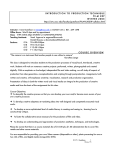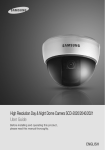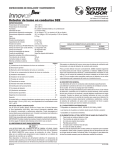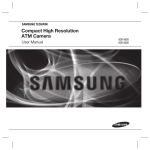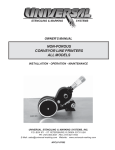Download Event electronic 20/20bas Computer Monitor User Manual
Transcript
20/20™ DIRECT FIELD MONITOR 20/20p™ POWERED MONITOR 20/20bas™ BIAMPLIFIED SYSTEM Event Electronics, LLC P.O. Box 4189 Santa Barbara, CA 93140-4189 Voice: (805) 566-7777 Fax: (805) 566-7771 Web: www.event1.com E-mail: [email protected] Your warranty will be in effect when you send in your warranty card Event, Event Electronics, 20/20, 2020p and 20/20bas are trademarks of Event Electronics, LLC. Specifications subject to change without notice © 1996, 1997, 1998 Event Electronics, LLC Printed in USA 6/98 1127 INTRODUCTION …………………….……….………….…………….…… 1 U NPACKING ……..……………….…………………………………….… 1 SETUP ………………………………….……………….………………… 1 20/20 CONNECTIONS TO AN EXTERNAL ………….………….… 2 AMPLIFIER 20/20bas CONNECTIONS AND OPERATION ………………………….… 3 20/20p CONNECTIONS AND OPERATION ………………………….… 5 CARE AND MAINTENANCE …………………………………………….… 7 20/20 SPECIFICATIONS …………………………………..……………… 7 20/20p SPECIFICATIONS …………………………………………….… 8 20/20bas SPECIFICATIONS …………………………………………….… 9 INTRODUCTION Thank you for choosing Event Electronics™ direct field monitors. Before you proceed, please take a minute to read this manual and familiarize yourself with the product’s features, set-up and use. Our engineers have spent over 25 years designing transducers, studio electronics and high performance studio monitor systems, including some of the most popular professional speakers used today. Now, using the latest in digital acoustic design tools along with high performance driver and power amplifier technology, we’ve developed the Event 20/20, 20/20p and 20/20bas systems, which extend the performance limits of direct field monitors once again. For years, small to mid sized monitors have been built using the twoway format employing a 6½-7" diameter woofer. Event engineers have developed an extended range 8" woofer that precisely blends with our reliable 1" silk dome high frequency driver to produce an exceptionally smooth frequency response with the deeper bass and bigger soundfield typical of a larger speaker. The front-mounted low air restriction bass port also adds to our monitors’ larger acoustic signature. The 20/20bas Biamplified System monitors build on the foundation of the passive 20/20 and realize the proven benefits of biamplification, including lowered distortion, smoother amplitude and phase response, extended bandwidth and convenience. The unique configuration of the 20/20p Powered Monitors with its passive crossover provide many of the performance benefits and all the convenience of a self-powered monitor system without the high cost. UNPACKING Check your speaker carefully. The packing container was designed to protect your speaker during transit; immediately report any damage to your dealer or to the company that delivered them to you. Also, please complete and return your warranty card to activate your warranty and to help us keep in touch with you. Please tell us what you think of your new monitor and of your Event dealer. SETUP The best performance from any speaker system comes with proper placement and use. There is no physical or acoustic distinction between individual left and right monitors when they are used in a stereo pair. Also, the cabinets can sit vertically or horizontally without concern for performance as long as both are situated similarly. For horizontal mounting, tip the cabinets outward so that the high frequency drivers are away from each other. Since the bass port is front mounted, you can mount the speakers near to, or even in, a wall without blocking the port. Place your monitors on a stable surface at about ear level. A typical location would be slightly behind and to either side of a small console. The distance between the monitors should equal the distance from the listener to either speaker. This is the common “equal length triangle” rule for speaker placement shown in Figure 1. 1 Model 20/20, 20/20p and 20/20bas specifications are subject to change without notice. 20/20bas SPECIFICATIONS LF Driver: HF Driver: Frequency Response: Crossover: Acoustical Crossover: LF Amplifier Power: HF Amplifier Power: Input Connector: Polarity: Input Impedance: Input Sensitivity: Input Level Control Range: LF Trim: HF Trim: Subsonic Filter: Protection: Indicators: Power Requirements: Cabinet: Dimensions: Weight: 8" mineral filled polypropylene cone with 1½" diameter high temperature voice coil, damped rubber surround and magnetic shielding. 1" natural silk dome with ferrofluid voice coil coolant and magnetic shielding 38Hz - 20kHz, ±2dB, Ref 500Hz Active fourth order 2.6kHz 130W continuous 70W continuous Combo XLR - ¼" connector with gold contacts accepts balanced or unbalanced sources Positive signal at + input produces outward cone displacement 40kΩ balanced, 20kΩ unbalanced 1.1V input produces full output with Input Level control at maximum 20dB Continuously variable control calibrated in 1dB increments; Max boost/cut settings produces ±3dB @ 100Hz, ±2dB @ 400Hz Continuously variable control calibrated in 1dB increments; Max boost/cut settings produces ±3dB above 2.6kHz -3dB @ 30Hz RF interference, output current limiting, over temperature, turn-on/off transient, subsonic filter, resettable mains circuit breaker Combination Power ON / Clip LED indicator Factory programmed for either 120V~ 60Hz, 220-240V~ 50/60Hz or 100V~ 50/60Hz, 200VA; Power via detachable 3 circuit IEC type linecord 5/8" vinyl laminated lock-mitered MDF 10¼" W x 14¾" H x 11¾" D 30 lbs. each 9 FIGURE 1. THE PRIME LISTENING POSITION OR SWEET SPOT. THE DISTANCE BETWEEN EACH SPEAKER AND THE MONITORING POSITION SHOULD BE EQUAL. Notice that Figure 1 also shows the speaker cabinets turned inward directly facing the listening position. This puts you in the sweet spot, which yields the most accurate stereo reproduction. If you need a wider sweet spot to allow for greater listener movement or for group monitoring, face the speakers in a slightly more open position, but never more than necessary. Finally, if you must mount the speakers substantially above or below ear level, then you will also need to tilt the cabinets downward or upward as well to keep them directly facing you. Once you start using your Event monitors, you may find it helpful to move around in their soundfield to locate their best position in your environment, but if you follow the equal distance, ear level, face-on rules, you’ve already optimized their position for a single user in most situations. 20/20 CONNECTIONS TO AN EXTERNAL POWER AMPLIFIER The passive Event 20/20 monitors present a 4 ohm nominal load impedance to the amplifier. Amplifiers rated for 8 ohm minimum loads are generally not suitable and may even suffer damage if used. We recommend using a power amplifier rated in the range of 100-200 watts per channel into 4 ohms. Higher power amplifiers can be used with caution, but care must be taken to never exceed the 20/20 monitor’s 150W program/200W peak ratings. Event is not responsible for damage caused by overpowering the speaker’s components. Connections to the monitors are made via 5-way binding posts on the rear panel. These terminals will accept large diameter bare or tinned wires, spade or pin terminals, or banana plugs. Use the shortest length of #10 to #14 gauge speaker wire to connect the positive (red) and negative (black) speaker terminals to the similarly marked terminals on your power amplifier. Watch for an accidental polarity reversal . . . it happens! The result will be loss of low frequency response and center image. 20/20bas’ high frequency output above 2.6kHz by ±3dB to accommodate personal preferences. 5 POWER SWITCH 1 = ON 0 = OFF When power is on, the green LED at the front of the speaker will illuminate. 2 20/20bas BIAMPLIFIED SYSTEM CONNECTIONS AND OPERATION Please refer to Figure 2. 1 2 INPUT SENSITIVITY This control has a 20dB range and compensates for different input signal levels. With the control at maximum, 1.1VRMS input will produce full amplifier output. If too much input signal is present, the amplifiers may overload, in which case the green LED at the front of the monitor will flash. INPUT CONNECTOR This jack has gold plated terminals and accepts both XLR and ¼" input plugs wired either balanced or single-ended. A 3conductor ¼" TRS or XLR plug is necessary for balanced input connections, but unbalanced wiring can also use either 3-conductor plug with the minus input left either unconnected or grounded. A 2-conductor ¼" TS type plug will also work for unbalanced sources, which automatically grounds the minus input. The input connector wiring is printed next to the connector and is as follows: 3 20/20p SPECIFICATIONS LF Driver: HF Driver: Frequency Response: Crossover: Acoustical Crossover: Amplifier Power: Input Connectors: Polarity: Input Impedance: Input Sensitivity: Input Level Control Range: LF Trim: NOTE: Use only good quality input connectors having industry standard sleeve dimensions. Some consumer grade ¼" TRS plugs do not provide reliable connections because of slight dimensional differences. 3 4 LOW FREQUENCY TRIM This controls the low frequency shelving boost/cut filter. The LF Trim filter has effect at frequencies below 400Hz and is fully engaged below 100Hz as shown on the rear panel response graphic. When the LF filter is set to “0”, the 20/20bas is designed to produce a flat LF response in the common “on the bridge or just behind the console” speaker mounting location. Locating the monitors in-wall or in a corner may require a reduction of low frequencies while free-standing in the open may require an increase in low end output for proper tone balance. The calibrated LF Trim filter allows for personal preferences in any monitoring situation. HIGH FREQUENCY TRIM Use this calibrated control to vary the HF Trim: Subsonic Filter: Protection: Indicators: Power Requirements: Cabinet: Dimensions: Weight: 8" mineral filled polypropylene cone with 1½" diameter high temperature voice coil, damped rubber surround and magnetic shielding. 1" natural silk dome with ferrofluid voice coil coolant and magnetic shielding 38Hz - 20kHz, ±2dB, Ref 500Hz Passive second order 2.2kHz 100W per channel continuous Combo XLR - ¼" TRS connectors with gold contacts accepts balanced or unbalanced sources Positive signal at + input produces outward cone displacement 40kΩ balanced, 20kΩ unbalanced 1.1V input produces full output with Input Level control at maximum 20dB Continuously variable control calibrated in 1dB increments; Max boost/cut settings produces ±3dB @ 100Hz, ±2dB @ 400Hz Continuously variable control calibrated in 1dB increments; Max boost/cut settings produces ±3dB above 2.3kHz -3dB @ 30Hz RF interference, output current limiting, over temperature, turnon/off transient, subsonic filter, resettable mains breaker Combination POWER ON / CLIP LED indicator Factory programmed for either 120V~ 60Hz, 220-240V~ 50/60Hz or 100V~ 50/60Hz, 400VA; Power via detachable 3 circuit IEC type linecord 5/8" vinyl laminated lock-mitered MDF 10¼" W x 14¾" H x 11¾" D 33 lbs. Powered Main Cabinet; 22 lbs. Passive 20/20 Satellite 20/20p POWERED MONITOR C ONNECTIONS AND OPERATION Please refer to Figure 3. 8 1 CHANNEL A The Channel A amplifier section powers the external passive 20/20 monitor through the A output connector. 2 CHANNEL B monitor. 3 7 A OUTPUT Delivers 100 watts to the companion passive 20/20 monitor. Use the speaker cable supplied to make this connection observing polarity (red to red, black to black). 8 POWER SWITCH 1 = ON 0 = OFF When amplifier power is on, the green LED at the front of the monitor will illuminate. 9 CIRCUIT B REAKER In the unlikely event of a protection or overload condition, the circuit breaker may open. If this occurs, the center button will pop out. Turn off the 5 Power and reset the breaker by pushing the button back in. Reapply power. If the breaker opens again you may have a problem requiring attention by qualified service personnel. DO NOT OPEN THE AMPLIFIER. THERE ARE NO USER SERVICABLE PARTS INSIDE. The Channel B amplifier section powers the internal 20/20 INPUT C ONNECTOR This jack has gold plated terminals and accepts both XLR and ¼" input plugs wired either balanced or single-ended. A 3-conductor ¼" TRS or XLR plug is necessary for balanced input connections, but unbalanced wiring can also use either 3-conductor plug with the minus input left either unconnected or grounded. A 2conductor ¼" TS type plug will also work for unbalanced sources, which automatically grounds the minus input. The input connector wiring is printed next to the connector and is as follows: NOTE: Use only good quality input connectors having industry standard sleeve dimensions. Some consumer grade ¼" TRS plugs do not provide reliable connections because of slight dimensional differences. 4 INPUT SENSITIVITY This control has a 20dB range and compensates for different input signal levels. With the control at maximum, 1.1VRMS input will produce full amplifier output. If too much input signal is present, the amplifiers may overload, in which case the green LED at the front of the powered monitor will flash. 5 HIGH FREQUENCY TRIM Use this calibrated control to vary the 20/20p’s high frequency output above 2.3kHz by ±3dB to accommodate personal preferences. 6 LOW FREQUENCY TRIM The calibrated LF Trim filter permits adjustments for personal preferences in any monitoring situation. The LF Trim filter is a shelving boost/cut filter having effect at frequencies below 400Hz and fully engaged below 100Hz as shown on the rear panel filter tuning graph. When the LF filter is set to “0”, the 20/20p produces flat LF response in the common “on the bridge or just behind the console” speaker mounting location. Locating the monitors in-wall or in a corner may require a reduction of low frequencies while free-standing in the open may require an increase in low end output for proper tonal balance. 10 POWER C ONNECTOR This connector accepts the detachable linecord. Use the linecord supplied with your monitors and make sure it is fully seated into the Power Inlet connector. For safety reasons, do not attempt to defeat the linecord’s ground connection. time increasing the resistance of the connection. If you are using banana plugs on the end of your speaker wires inserted into the binding posts, keep the unused binding post screw terminals tight. They may rattle or buzz if loose. Mix at reasonable levels to protect your speakers and your hearing. service to qualified personnel. Refer 20/20 SPECIFICATIONS LF Driver: HF Driver: Crossover: Frequency Response: Power Handling: Nominal Impedance: Sensitivity: Cabinet: Connectors: Polarity: Dimensions: Weight: 8" mineral filled polypropylene cone with 1½" diameter high temperature voice coil, damped rubber surround and magnetic shielding. 1" natural silk dome with ferrofluid voice coil coolant and magnetic shielding 2.2kHz, second order 50Hz - 20kHz, ±2dB, Ref 500Hz 150W program, 200W peak 4Ω 88dB @ 1W, 1m 5/8” vinyl laminated lock-mitered MDF Red and black 5-way binding posts on ¾" centers Positive signal at red terminal produces outward cone displacement 10¼" W x 14¾" H x 11¾" D 22 lbs. each FIGURE 3. THE 20/20p REAR PANEL 6 CARE AND MAINTENANCE Your Event Direct Field Monitors will not require any special care or maintenance if properly used. The cabinet is finished with a durable vinyl laminate that can be cleaned with a soft damp cloth. Avoid touching the exposed speaker elements. Do not expose the rear panel controls, connectors, or the speaker elements to moisture. Check the 20/20 and 20/20p’s external speaker wire connections occasionally for tightness. The bare wires attached to the binding post can become loose over 7 6 CIRCUIT BREAKER In the unlikely event of a protection or overload condition, the circuit breaker may open. If this occurs, the center button will pop out. Turn off the power and reset the breaker by pushing the button back in. Reapply power. If the breaker opens again you may have a problem requiring attention by qualified service personnel. DO NOT OPEN THE AMPLIFIER. THERE ARE NO USER SERVICABLE PARTS INSIDE. 7 POWER CONNECTOR This connector accepts the detachable linecord. Use the linecord supplied with your monitors and make sure it is fully seated into the Power Inlet connector. For safety reasons, do not attempt to defeat the linecord’s ground connection. FIGURE 2. THE 20/20bas REAR PANEL 4








